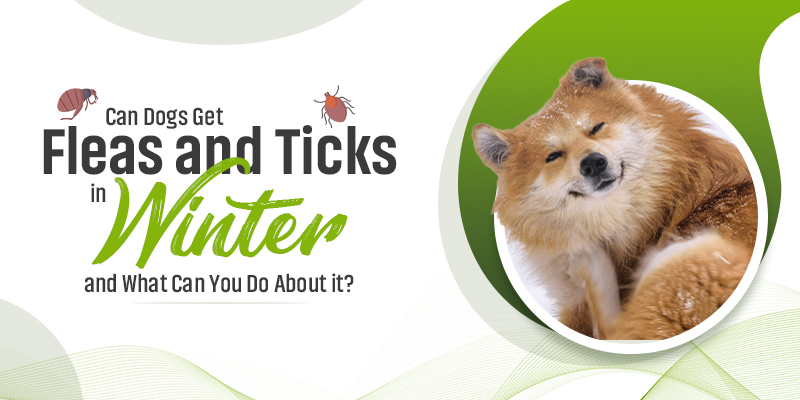Can Dogs Get Fleas and Ticks in Winter, and What Can You Do About it?

When the temperature drops and snow begins to blanket the grounds, many pet parents breathe a sigh of relief, assuming that flea and tick season is finally over. But the sad reality is winter doesn’t stop these tiny troublemakers. From cozy indoor hideouts to unexpected warm spells, these parasites find sneaky ways to survive and thrive, later becoming a problem for your dog.
In this informative blog, we’ll uncover how fleas and ticks remain active during winter and the risks they pose. Most importantly, we’ll discuss valuable measures to help protect your furry friend from these pesky parasites all year round.
Let’s start with brushing up on the fundamentals!
Is Flea and Tick Prevention Necessary in the Winter?
Absolutely, it is! While it’s true that these parasites are less active outdoors during freezing temperatures, they don’t simply vanish. In fact, fleas and ticks are remarkably resilient and can find various ways to survive throughout the year, making year-round protection imperative.
Skipping winter protection can create a dangerous gap in your pet’s protection. In the absence of a proactive prevention plan, your beloved doggo will remain vulnerable to the threats that these pesky parasites carry.
Let’s further understand these risks:
Risk of Fleas in Winter
The following factors underline how fleas can bring health issues for your dog in winters:
- Indoor survival: During winters, fleas can survive in warm indoors, hiding in carpets, bedding, or upholstery.
- Persistent life cycle: Fleas have an intricate life cycle with fleas, eggs, larvae, and pupae that can survive for weeks to months indoors and hatch with favorable conditions.
- Diseases and discomfort: Fleas can inflict various skin issues, including flea allergy dermatitis, causing intense itching and scratching. They can also transmit tapeworms, leading to intestinal issues.
- Infestation risk: Fleas can multiply fast, so if not addressed timely, even a single flea can result in a full-blown house infestation and cause greater troubles for your dog.
Risk of Ticks in Winter
These observations will highlight why ticks continue to plague pets even during winters.
- Cold-hardy species: Ticks are surprisingly cold-hardy and can survive freezing temperatures by finding shelter and going dormant. They become active on warm days and look for blood meals, infecting your pet in the process.
- Outdoor exposure: Ticks can lurk in leaf litter in your yard, tall grass, and wooded areas even during winter months and jump onto your pet when they pass by.
- Disease carriers: Ticks can transmit serious illnesses such as Lyme disease, ehrlichiosis, and anaplasmosis, which can be life-threatening if not addressed timely.
How Can Your Dog Get Fleas and Ticks in the Winter?
There are several ways fleas and ticks can get to your dog. Here are some of the common ways:
1. Eggs and larvae
Flea eggs and larvae can take refuge in the nooks and crevices of your house and survive for months before hatching in the right conditions. Moreover, the pupae stage is especially hard to eliminate, as they are resistant to flea and tick treatments.
2. Contact with fellow pets
Your dog can also get these parasites while interacting with fellow pets during walks, while visiting the vet, or while playing in the park. These close encounters offer fleas and ticks chances to jump onto your pet and infect them.
3. Human visitors
Apart from fellow pets, fleas and ticks can also hitch a ride on your visitors’ clothes and shoes and enter your home.
4. Wildlife
Your dog may also pick up these parasites by ingesting them or coming in contact with wild animals in your yard, such as squirrels or rodents.
5. Warm Indoor
Fleas and ticks require warmth to survive, which they can easily get in your homes during winters. Moreover, they can hide in your bedding, carpets, and furniture, looking for opportunities to infect your dog.
6. Warm outdoor days
Those unexpected warm days during winter give fleas and tick the chance to become active and infect your pet when they are out enjoying the warmth.
Common Symptoms of Fleas and Ticks in Dogs
The following signs will help you identify the presence of fleas and ticks in dogs.
- Excessive scratching, biting, or licking
- Red, irritated skin or scabs
- Visible fleas or flea dirt on the coat
- Small bumps or embedded ticks on the skin
- Lethargy or decreased appetite
- Shortness of breath
- Pale gums
- Fever or swollen lymph nodes (in case of tick-borne illnesses)
- Hair loss, especially around the tail or neck
If you notice some or all of these symptoms in your dog, promptly take your dog to the vet and get them the help they need.
Measures to Prevent Flea and Tick Infestations
By following these preventive measures, you can keep your dog far from the dangers of these pesky parasites regardless of the season.
- Practice regular grooming and bathing to spot and remove parasites early.
- Seal the cracks and crevices in your home.
- Keep your yard clean from dry leaves, branches, and debris.
- Regularly mow your lawn and maintain the length of the grass.
- When going out for walks, avoid heavily wooded areas and areas with tall grasses.
- Inspect your pet after every outing, especially around their ears, neck, and paws.
- Periodically vacuum and wash your pet’s bedding and toys with warm water.
- Limit your dog’s exposure to stray animals or wildlife.
- Maintain regular vet visits and take follow-ups.
- Administer flea and tick treatments such as Simparica Trio, Bravecto Chewable, or Nexgard after consulting with your vet.
Parting Words
We hope that with this blog, you realize the importance of flea and tick prevention during winters. Since fleas and ticks don’t take a winter vacation, your prevention plan must also not. With the valuable information shared in this blog, you can keep your beloved pup safe even when winter sets in!
And always remember to consult your vet for any query. They will provide professional advice as per your dog’s condition and medical history.

David joined CanadaVetCare in 2013 as a product analyst and veterinary assistant. Being a passionate pet lover and keen animal health researcher, David had always found ways and solutions to help pet parents to improve their pets’ health. He is always happy to answer pet health-related queries and recommending pet parents for the right pet product for their furry companions.




